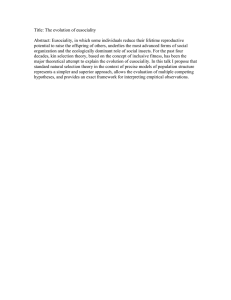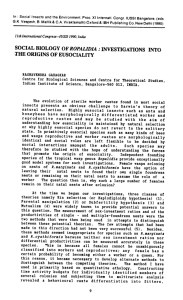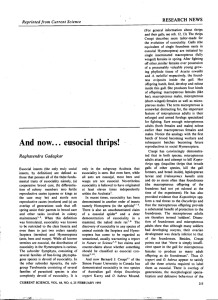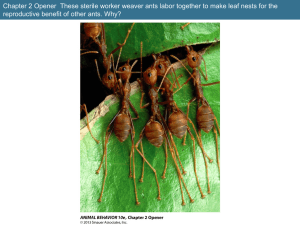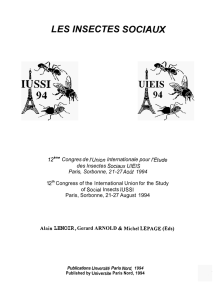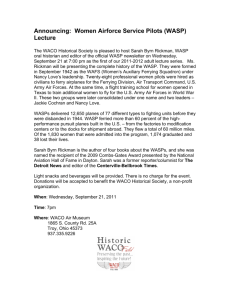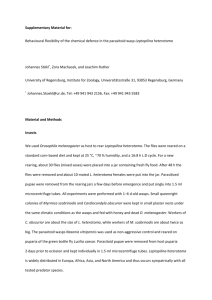Origin and evolution of eusociality: ... primitively eusocial wasps RAGHAVENDRAGADAGKAR
advertisement
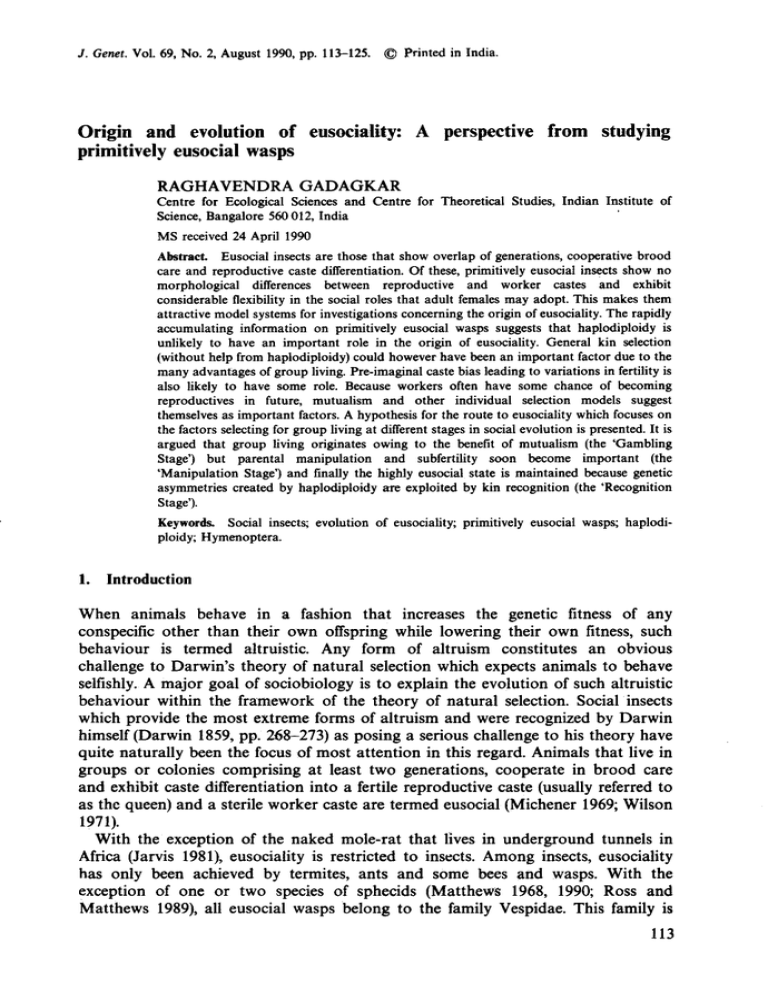
J. Genet.Vol. 69, No.2, August 1990,pp. 113-125. @ printed in India. Origin and evolution of eusociality: A perspective from studying primitively eusocialwasps RAGHAVENDRAGADAGKAR Centre for Ecological Sciencesand Centre for Theoretical Studies, Indian Institute of Science,Bangalore 560012, India ' MS received24 April 1990 Abstract. Eusocial insectsare those that show overlap of generations,cooperative brood care and reproductive caste differentiation. Of these,primitively eusocial insects show no morphological differences between reproductive and worker castes and exhibit considerable flexibility in the social roles that adult females may adopt. This makes them attractive model systemsfor investigationsconcerning the origin of eusociality.The rapidly accumulating information on primitively eusocial wasps suggests that haplodiploidy is unlikely to have an important role in the origin of eusociality. General kin selection (without help from haplodiploidy) could howeverhave beenan important factor due to the many advantagesof group living. Pre-imaginalcastebias leading to variations in fertility is also likely to have some role. Becauseworkers often have some chance of becoming reproductives in future, mutualism and other individual selection models suggest themselvesas important factors. A hypothesisfor the route to eusociality which focuseson the factors selectingfor group living at different stagesin social evolution is presented.It is argued that group living originates owing to the benefit of mutualism (the 'Gambling Stage') but parental manipulation and subfertility soon become important (the 'Manipulation Stage')and finally the highly eusocial state is maintained becausegenetic asymmetriescreated by haplodiploidy are exploited by kin recognition (the 'Recognition Stage'). Keywords. Social insects; evolution of eusociality; primitively eusocial wasps; haplodiploidy; Hymenoptera. 1. Introduction When animals behave in a fashion that increases the genetic fitness of any conspecific other than their own offspring while lowering their own fitness, such behaviour is termed altruistic. Any form of altruism constitutes an obvious challenge to Darwin's theory of natural selection which expectsanimals to behave selfishly. A major goal of sociobiology is to explain the evolution of such altruistic behaviour within the framework of the theory of natural selection. Social insects which provide the most extreme forms of altruism and were recognizedby Darwin himself (Darwin 1859,pp. 268-273)as posing a seriouschallengeto his theory have quite naturally beenthe focus of most attention in this regard. Animals that live in groups or colonies comprising at least two generations,cooperate in brood care and exhibit caste differentiation into a fertile reproductive caste (usually referred to as the queen)and a sterile worker casteare termed eusocial(Michener 1969;Wilson 1971). With the exception of the naked mole-rat that lives in underground tunnels in Africa (Jarvis 1981), eusociality is restricted to ins~cts. Among insects, eusociality has only been achieved by termites, ants and some bees and wasps. With the exception of one or two species of sphecids (Matthews 1968, 1990; Ross and Matthews 1989), all eusocial wasps belong to the family Vespidae.This family is 113 116 RaghavendraGadagkar " I rl > tm, t\\"" (1) 1= 1 where n is the number of individuals (offspring or other relatives) reared in the group mode, ri is the coefficient of genetic relatednessto theseindividuals and m is the number of offspring reared in the solitary mode. 4. The haplodiploidyhypothesis One way in which the inequality in (1) may be obtained is for rj to be greater than t, that is, for genetic relatednessto other relatives to be greater than that to offspring. This may potentially be achieved with a haplodiploid genetic system, where genetic relatedness between a female and her full-sisters is 0.75, which is greater than the value between a female and her daughters (r=0'5). Since an overwhelming number of the origins of eusocialityhave occurred in the insect order Hymenoptera, in which haplodiploidy is universal,much attention has beenpaid to the possibility that haplodiploidy predisposesHymenopterans to eusociality. This so-called haplodiploidy hypothesisrequires several conditions, however. Colonies should consist of a single egg-layermated to a single male so that workers need not rear any half-sisters or more distantly related individuals. Workers must either successfullyskew investment in favour of their sisters or must be able to rear their own sons instead of brothers. The latter condition is necessarybecauseworkers are related to their brothers by only 0.25 while they are related to their sons by 0,5. Many features of the biology of primitively eusocial wasps suggest that these conditions may not always be met. In Belonogasterpetiolata, only 15% of foundress associationsconsist exclusivelyof former nestmates,so that cofoundressesprobably are not often closely related (Keeping and Crewe 1987). Even when they are, subordinate cofoundressesare at best sisters of the egg-layerand are thus helping raise nieces and nephews (r=0'375). In many species,queen supersedure(Pardi 1948; West-Eberhard 1969;Jeanne 1972; Metcalf and Whitt 1977; Gamboa et al. 1978;Yamane 1986;Gadagkar et at. 1990b)must act to reduce relatednessbetween workers and the brood they rear. Polygyny, or the simultaneouspresenceof more than one egg-layer,has been reported in Mischocyttarus mexicanusfall nests(Litte 1977),Ropalidia cyathiformis (Gadagkar and Joshi 1982, 1984),Ropatidia variegata jacobsoni (Yamane 1986)and Ropalidia fasciata (Ito 1986b).Nests are frequently usurped by foreign conspecifics in Mischocyttarus jlavitarsis (Litte 1979). These factors should also considerablyreduceworker-brood relatedness.Fina1Jy,multiple mating by the egg-layeris known in Ropalidia marginata (Muralidharan et at. 1986), so that even when daughters are working solely for their mothers they may be rearing mixtures of full- and half-sisters.Levels of intra-colony genetic relatedness determined using electrophoretic separation of isozymesare now available for l' speciesof primitively eusocialwasps (Gadagkar 1990b).Of the 13 speciesfor which estimateswith standard error are available, only 2 specieshave values high enough for rj in that group mode to be greater than t (Gadagkar 1990b,c, d). Polygyny or multiple mating by the queenshould pose no great difficulty for the haplodiploidy hypothesis if workers discriminate between full-sisters and less related individuals, giving prefereptial aid to the former (Gadagkar 1985b). However, studies of nestmate discrimination suggestthat the labels and templates used in discrimination are not produced individuallx.. but rather are acquired from Origin and evolution of eusociality 117 a common external source, namely the natal nest or nestmates,making it unlikely that different levels of genetic relatedness can be effectively recognized among membersof the same colony (Gadagkar 1985b;Gamboa et al. 1986;Venkataraman et at. 1988; Queller et at. 1990). Thus it seems likely that workers in these primitively eusocial wasps often rear complex mixtures of full-sisters, half-sisters, nieces,daughters,brothers, nephews,sons,and cousins,and probably do so without the ability to discriminate on the basis of genetic relatedness.Becauser in such societies rarely exceedst, it has been increasingly suspectedthat haplodiploidy is not as important a factor in the origin of insect sociality as was thought earlier (Evans 1977;West-Eberhard 1978;Andersson1984;Stubblefieldand Charnov 1986; Venkataraman et at. 1988;Gadagkar 1990b,c,d). Even if ri is rarely much greater than t, the inequality in (1) can nonethelessbe achievedif n > m; indeed, this is true even if r in the group mode is smaller than t, provided n is that much greater than m. The ecology of independent-founding polistine waspssuggeststhat there must be substantialbenefitsto group living, that is, n must often be greater than m. For instance,the probability of survival of singlefoundress colonies is certainly small, as the nest and its brood are extremely vulnerable to predators and parasites and to usurpation by conspecifics (e.g., Gamboa 1978; Suzuki and Murai 1980). Yet the effectivenessof protection from such enemiesby even one or two supernumeraryadults is obvious to anyone who has watched these wasp colonies.Furthermore, multiple foundressesare more likely to be able to re-build a damaged nest than are single foundresses.This latter factor favours multiple-foundress nests even when the destructive agent is itself indifferent to group size,as in the caseof predation by birds or destruction by typhoons (Litte 1977, 1979, 1981; Ito 1986b; Strassmann et at. 1988). The origin of eusociality therefore probably has much more to do with such benefits of group living and associated gains in inclusive fitness than with haplodiploidy. This is sometimes called general kin selection to distinguish it from the role of haplodiploidy in facilitating kin selection. 5. Parental manipulation or the subfertility hypothesis There is another way by which the inequality in (1) may be attained, without the involvement of haplodiploidy. Ecological conditions may exist in which a parent who manipulates a fraction of her offspring into being sterile and helping rear her remaining (fertile) offspring leaves behind more grandchildren than her wild-type counterpart. This idea, often known as the parental manipulation hypothesis,was first suggestedby Alexander (1974). A significant problem with this is whether counter-selection on the offspring would be successfulin making them overcome parental manipulation. A related idea which gets around this problem is the subfertility hypothesis of West-Eberhard (1975), which simply reminds us that subfertile femalesproduced by whatever cause (even by accidental variation in the quantity of food obtained as larvae) will find it 'easier' to give up reproduction and accepta worker role. That is, their m will be so small that the inequality in (1) may be satisfied rather easily. The generalideas embodied in the parental manipulation and subfertility hypotheses have found support in theoretical (Stubblefield and Charnov 1986),modelling (Craig 1979,1983),and empirical (Michener and Brothers 1974)studies,and there seemsto be little doubt that subfertility caused by parental . rt~:;;!;i~;~"iiI!¥;j\ Origin and evolution of eusociality 119 solitary mode, and if the roles of queenand sterile worker are assignedrandomly, then wasps who take the risk of joint nesting will, on average, produce 10.5 offspring and thereby do better than those who shy away from the risks of joint nesting. In this "Gambling" model, benefits of group living can be infinitesimally small, and abilities of parents to manipulate their offspring or of colony membersto discriminate on the basis of differential genetic relatednessare not necessary.Many features of primitively eusocial species such as simultaneous or serial polygyny, queensupersedure,nest usurpation, colony fission, behavioural caste differentiation, the differentiation of potential queensand the occasionalpresenceof non-nestmates in foundressassociationslend credibility to the idea that sociality may arise due to the benefits of mutualism, reciprocal altruism and "Gambling". 7. A hypothesisconcerningthe route to eusociality It is sometimes stated that haplodiploidy, parental manipulation, and mutualism are not mutually exclusive and that they may all have had a place in shaping the evolution of insect societies.Such a statementis perhaps'of little value unless one can assign more specific roles to each force (theory). I shall now propose a hypothesis concerningthe route to eusociality that will do just that. I propose that there are three sequential stagesin the evolution of eusociality (figure 1). It seems reasonable that the initial incentive for group living comes from mutualism, reciprocal altruism, and the benefits of "Gambling". I shall call this the Gambling THE ROUTE TO EUSOCIALITY I. THE GAMBLING STAGE II. THE MANIPULATION STAGE variatKlns III. THE RECOGNITION STAGE Group n~sting is Acci~ntat for mutual b~n~fit Eith~r all individuals in f.rtiliti.s or. .xploit.d to usurp cr~at~d by haplodiploidy ar~ lay ~gs or t~ ~gg lay~r is d.cid~d by ~ -laying opportuniti~s ~xploit~d by showing pr~f~r~ntiat altruism by ~n~tic asymm~tries chanc~. An av~ra9t' som~ individuals toward clos~ r~latiindividual ckI~s or Suffici~nt inclusiv~ b~tt~r than a soliklry -..som~ individuals ar~ -..fitn~ss is thus on~. manipulat~d into gain~d to compenmfe .E.g., J-t1ny~social subf~rtil~ and for r~duc~d and JOfM primitiwly subordinat~ rol~s opportunities for .u.social wasps and E. g, Som~ IN"imitiwly r~production ~~s .usocial wasps and E. g., Many ants, bHS hon.y~.s. Figure 1. The route to eusociality, a hypothesis concerning the evolution of the highly eusocial state from the solitary state through the Gambling,Manipulation, and Recognition stages.The examplesgiven for eachstageare tentative as our knowledge of the causesand consequencesof group living in most social insectgroups is rather sketchy. 120 Raghavendra Gadagkar Stage. This stage requires no preadaptation for intra-group manipulation or for recognition of genetic relatedness,although group living among kin (who might come together merely by virtue of being neighbours)will evolve more easily (WestEberhard 1978; Schwarz 1988).The only prerequisite for the evolution of incipient societiesby mutualism is a sufficiently complex behavioural repertoire to permit the necessaryinteractions; solitary wasps seem to possessan appropriately diverse array of behaviours (Tinbergen 1932,1935;Tinbergen and Kruyt 1938; Brockmann and Dawkins 1979; Brockmann et al. 1979). It is easy to imagine that many presocial wasps much as those listed in West-Eberhard (1978) and described by West-Eberhard (1987)and Wcislo et al. (1988)are either already at this stage or are immediate forerunners of this stage. Once group living is established,the stageis set for the secondstage which I shall call the Manipulation Stage. Accidental variations in food supply leading to subfertility can now be exploited and the ability to manipulate offspring or other nestmates can be selected for. As manipulation becomes increasingly effective, benefits of group living become increasingly unavailable to some individuals who begin to lose reproductive options and get trapped into worker roles. It is precisely at this stage that the ability to recognizeand give preferentialaid to closer relatives will begin to have selective value. This is the final stage which I shall call the RecognitionStage.In other words, I propose that the benefits of haplodiploidy for social evolution becomeavailable at this final stage. This hypothesis explains one otherwise curious fact. Although kin recognition and nestmate discrimination studies have a long way to go, there is a growing impression that primitively eusocialspeciesmay not have the ability to discriminate betweendifferent levels of genetic relatednessonce all the individuals (the less and the more related ones)are part of the samecolony. On the other hand, there are at least some examples among highly eusocial speciessuch as honey bees and ants where there is clear evidence of the ability to distinguish between levels of relatednesswithin a colony (reviewed in Gadagkar 1985b, Venkataraman et al. 1988;seealso Page et al. 1989, Queller et al. 1990).If haplodiploidy was important for the origins of insect sociality one would expect workers in primitively eusocial speciesto exploit the genetic asymmetriesthus created by discriminating between close and distant relatives. But if the origin of eusociality is due to mutualistic benefits,as assumedhere, and its subsequentmaintenancein highly eusocialforms is due largely to haplodiploidy, the observed distribution of kinship discrimination abilities is no longer a paradox. Indeed, it is difficult to imagine how the ability to manipulate conspecifics or to discriminate between different levels of genetic relatednessamong conspecifics (of the same sex) would have had selective value prior to the advent of group living. The problem of the route to eusocialityhas receivedconsiderableattention in the past (Wilson 1971).William Morton Wheeler (Wheeler 1923,1928)who was greatly influenced by the early studies on wasps,formally proposed and championed the so called "subsocial" route. This hypothesis envisages that colonies with extended maternal care are starting points for the ultimate evolution of the habit of the daughters to stay back and help their mother produce more offspring. Realising the obvious inappropriatenessof this hypothesis for many bees, Michener (1958; see also Lin and Michener 1972,Michener 1974)proposed the "semisocial" route and argued that associationsof adults of the same generation rather than a family unit Origin and evolutionof eusociality 121 containing two generations is a more likely starting point. More recently, WestEberhard (1978; see also Carpenter 1989, 1990) has modified the semisocial hypothesis and proposed the "polygynous family" hypothesis,which insists that the starting point must have consisted of close relatives. The route to eusociality proposed in this paper is consistent with each of the three hypothesesmentioned above. But it differs from thesehypothesesin that its focus is not on the kinds of individuals or colonies that occur in different stages in evolution but on the selectiveadvantages of group living that must have sustained social evolution at different stages.Becausethe kinds of colonies or associationsdo not necessarily specifythe selectiveadvantagesthat promote them, such a focus is important. To take just one example,groups of femalesof the same generation may only find it worthwhile to form a colony if every individual has a certain probability of laying eggs.On the other hand, a colony may consist of daughters helping their mothers produce more offspring but the daughters may be selectedto stay back and help their mothers only if there is a certain probability of their eventually taking over the role of egg-layerin that colony. 8. Conclusion Our understanding of the origin and evolution of eusociality is bound to go through many more twists and turns. It is also possible that eusociality has arisen by different routes and for different reasonsin different groups. For this reason, perspectivesfrom studying diverse eusocial groups are important. Our present knowledge (admittedly very limited and biased) of primitively eusocial wasps suggeststhat the advantagesof mutualism, reciprocal altruism and "Gambling" are likely to have beenmore important than haplodiploidy in the origin of eusociality. The maintenance of eusociality is another matter however. Although primitively eusocialwaspscannot tell us much about this, it seemslikely that haplodiploidy has a significant role to play in the maintenanceof the highly eusocialstage. Acknowledgement I thank Madhav Gadgil and N. V. Joshi for comments on an earlier draft of this paper. Supported in part by a grant from the Department of Science and Technology, Governmentof India. References Alexander R. D. 1974The evolution of social behaviour. Annu. Rev. Ecol. Syst.5: 325-83 Anderson R. H. 1963The laying worker in the Cape honey bee,Apis mellifera capensis.J. Apic. Res.2: 85-92 Andersson M. 1984The evolution of eusociality. Annu. Rev. Ecol. Syst. 15: 165-189 Brian M. V. 1980 Social control over sex and caste in bees,w~ps and ants. Bioi. Rev.55: 379-415 Brockmann H. J. 1984 The evolution of social behaviour in insects. In Behavioural ecology: An evolutionary approach, 2nd edn (eds) J. R. Krebs and N. B. Davies (Sunderland, Mass: Sinauer) pp. 340-361 Brockmann H. J. and Dawkins R. 1979Joint nesting in a digger wasp as an evolutionarily stable preadaptation to social life. Behaviour71: 204-245 122 Raghavendra Gadagkar Brockmann H. J., Grafen A. and Dawkins R. 1979 Evolutionarily stable nesting strategy in a digger wasp. J. Theor. Bioi. 77: 473-496 Carpenter J. M. 1989Testing scenarios:Wasp social behaviour. Cladistics5: 131-144 Carpenter J. M. 1990 Phylogenetic relationships in the Vespidae. In Social biology of wasps (eds) K. G. Ross and R. W. Matthews (Ithaca, NY: Cornell University Press)(in press) Charnov E. L. 1978 Evolution of eusocial behavior: Offspring choice or parental parasitism?J. Theor. Bioi. 75:.451-465 Craig R. 1979Parental manipulation, kin selection,and the evolution of altruism. Evolution 33: 319-334 Craig R. 1980 Sex ratio changesand the evolution of eusociality in the Hymenoptera: Simulation and games theory studies.J. Theor. Bioi. 87: 55-70 (:raig R. 1983Subfertility and the evolution of eusociality by kin selection. J. Theor.Bioi. 100: 379-397 Crozier R. H. 1977Evolutionary genetics of the Hymenoptera. Annu. Rev. Entomol.22: 263-288 Darwin C. 1859The origin ofspecies(New York: Collier, 1962) Evans H. E. 1977Extrinsic versus intrinsic factors in the evolution of insect sociality. Bioscience27: 613-617 Fletcher D. J. C. and Ross K. G. 1985Regulation of reproduction in eusocialHymenoptera. Annu. Rev. Entomol.30: 319-343 Gadagkar R. 1985a Evolution of insect sociality-A review of some attempts to test modern theories. Proc. Indian Acad. Sci. (Anim. Sci.)94: 309-324 Gadagkar R. 1985bKin recognition in social insectsand other animals-A review of recent findings and a consideration of their relevancefor the theory of kin selection. Proc. Indian Acad. Sci. (Anim. Sci.) 94: 587-621 GadagkarR. 1987Social structure and the determinants of queen status in the primitiv~ly eusocial wasp Ropalidia cyathiformis.In Chemistryand biology of social insects,Proceedingsof the X International Congressof IUSSI (eds)J. Eder and H. Rembold (Munich: Verlag J. Peperny)pp. 377-378 Gadagkar R. 1990a Belonogaster,Mischocyttarus,Parapolybia and independent founding Ropalidia. In Social biology of wasps(eds)K. G. Ross and R. W. Matthews (Ithaca, NY: Cornell University Press) (in press) Gadagkar R. 1990b On testing the haplodiploidy hypothesis for the evolution of eusociality in the Hymenoptera. Behav.Ecol. Sociobiol.(submitted) Gadagkar R. 199OcThe hap1odiploidy threshold and social evolution. CurroSci. 59: 374-376 Gadagkar R. 199OdA test of the role of haplodiploidy in the evolution of hymenopteran eusociality. In Social insects and the environment.Proceedings of the 11th International Congress of IUSSI (eds)G. K. Veeresh, B. Mallik and C. A. Viraktamath (New Delhi: Oxford and IBH) pp. 539-540 Gadagkar R., Bhagavan S., Malpe R. and Vinutha C. 1990a On reconfirming the evidence for preimaginal caste bias in a primitively eusocialwasp. Proc. Indian Acad. Sci. (Anim. Sci.)99: 141-150 Gadagkar R., Chandrashekara K., Chandran S. and Bhagavan S. 1990b Serial polygyny in Ropalidia marginata: Implications for the evolution of eusociality. In So~ial insects and the environment. Proceedings of the 11th International Congress of IUSSI (eds) G. K. Veeresh, B. Mallik and C. A. Viraktamath (New Delhi: Oxford and IBH) pp. 227-228 Gadagkar R. and Joshi N. V. 1982Behaviour of the Indian social wasp Ropalidia cyathiformison a nest ,of separatecombs (Hymenoptera,Vespidae).J. Zool. (London)198: 27-37 Gadagkar R. and Joshi N. V. 1984 Social organisation in the Indian wasp, Ropalidia cyathiformis (Hymenoptera,Vespidae).Z. Tierpsychol.64: 15-32 Gadagkar R. and Joshi N. V. 1985Colony fission in a social wasp. CurroSci. 54: 57-62 Gadagkar R., Vinutha C., ShanubhogueA. and Gore A. P. 1988 Pre-Imaginal biasing of caste in a primitively eusocialinsect. Proc. R. Soc. London B233: 175-189 Gamboa G. J. 1978 Intraspecific defense: Advantase of social cooperation among paper wasp foundresses.Science199: 1463-1465 Gamboa G. J., Heacock B. D. and Wiltjer S. L. 1978 Division of labor and subordinate longevity in foundress associations of the paper wasp Polistes metricus (Hymenoptera: Vespidae). J. Kans. Entomal. Soc.51: 343-352 Gamboa G. J., Reeve H. K. and Pfenning D. W. 1986 The evolution and ontogeny of nestmate recognition in social wasps.Annu. Rev.Entomol. 31: 431-454 Gibo D. L. 1974 A laboratory study on the selectiveadvantage of foundress associations in Polistes fuscatus(Hymenoptera: Vespidae).Can. Entomol. 106: 101-106 Greene A. 1990 Dolichovespulaand Vespula. In Social biology of wasps (eds) K. G. Ross and R. W. Matthews (Ithaca, New York: Cornell University Press)(in press) Origin and evolution of eusociality 123 Hamilton W. D. 1964aThe genetical evolution of social behaviour I. J. 11Ieor.Bioi. 7: 1-16 Hamilton W. D. 1964bThe genetical evolution of social behaviour II. J. 11Ieor.Bioi. 7: 17-52 Hamilton W. D. 1972Altruism and related phenomena,mainly in social insects.Annu. Rev.Ecol. Syst. 3: 192-232 Hansell M. 1987 Nest building as a facilitating and limiting factor in the evolution of eusociality in the Hymenoptera. Oxford surveysin evolutionary biology4: 155-181 Hunt J. H. 1988 Lobe ereCtion behavior and its possible social role in larvae of Mischocyttarus paper wasps.J. Insect Behav.1: 379-386 Hunt J. H. 1990 Nourishment and the evolution of social Vespidae. In Social biology of wasps (eds) K. G. Ross and R. W. Mathews (Ithaca, NY: Cornell University Press)(in press) Ito Y. 1986a On the pleometrotic route of social evolution in the Vespidae.Monit. Zool. Ital. (N.S.)20: 241-262 Ito Y. 1986b Social behaviour of Ropalidia fasciata (Hymenoptera: Vespidae)femaleson satellite nests and on a nest with multiple combs.J. Ethol. 4: 73-80 . Ito Y. 1987 Role of pleometrosis in the evolution of eusociality in wasps. In Animal societies: Theories and facts (eds)Y. Ito, J. L. Brown and J. Kikkawa (Tokyo: Japan Sci. Soc. Press)pp. 17-34 Jarvis J. U. M. 1981 Eusociality in a mammal: Cooperative breeding in naked mole-rat colonies. Science. 212: 571-573 JeanneR. L. 1972 Social biology of the neotropical wasp Mischocyttarus drewseni.Bull. Mus. Compo Zool. Harv. Univ. 144:63-150 JeanneR. L. 1980 Evolution of social behaviour in the Vespidae.Annu. Rev. Entomol.25: 371-396 JeanneR. L. 1990The swarm-founding Polistinae. In Social,biology of wasps (eds)K. G. Ross and R. W. Matthews (Ithaca, NY: Cornell University Press)(in press) Joshi N. V. and Gadagkar R. 1985 Evolution of sex ratios in social hymenoptera: Kin selection, local mate competition, polyandry and kin recognition. J. Genet.64: 41-58 Keeping M. G. and Crewe R. M. 1987 The ontogeny and evolution of foundress associations in Belonogaster petiolata (Hymenoptera: Vespidae). In Chemistry and biology of social insects, Proceedings ofthe X International Congress ofIUSSI (eds)J. Eder and H. Rembold(Munich: Verlag J. Peperny)pp. 383-384 Lin N. and Michener C. D. 1972 Evolution of sociality in insects..Q.Rev. Bioi. 47: 131-159 Litte M. 1977 Behavioural ecology of the social wasp, Mischocyttarusmexicanus.Behav.Ecol. Sociobiol. 2: 229-246 Litte M. 1979 Mischocyttarusjlavitarsis in Arizona, social and nesting biology of a Polistine wasp. Z. Tierpsychol.50: 282-312 Litte M. 1981 Social biology of the polistine wasp,Mischocyttaruslabiatus: Survival in a Colombian rain forest. Smithson.Contrib. Zool. 327: 1-28 Matsuura M. 1990 Vespaand Provespa.In Social biologyof wasps(eds)K. G. Rossand R. W. Matthews (Ithaca, NY: Cornell University Press)(in press) Matthews R. W. 1968Microstigmuscomes:sociality in a sphecidwasp. Science.160: 787-788 Matthews R. W. 1990 Evolution of social behaviour in sphecid wasps. In Social biology of wasps(eds) K. G. Rossand R. W. Matthews (Ithaca, NY: Cornell University Press)(in press) Metcalf R. A. and Whitt G. S. 1977 Relative inclusive fitnessin the social wasp Polistesmetricus.Behav. Ecol. Sociobiol.2: 353-360 MichenerC. D. 1958The evolution of social behaviour in bees.Proc. X Int. Congr. Entomol. (Montreal) 2: 441-448 Michener C. D. 1969 ColJlparative social behaviour of bees.Annu.Rev. Entomol. 14: 299-342 Michener C. D. 1974 The social behavior of the bees: A comparativestudy. (Cambridge,Mass: Harvard University Press) Michener C. D. and Brothers D. J. 1974Were workers of eusocialHymenoptera initially altruistic or oppressed?Proc. Natl. Acad. Sci. USA 71: 671-674 Muralidharan K., Shaila M. S. and Gadagk:arR. 1986Evidence for multiple mating in the primitively eusocial waspRopalidia marginata (Lep.)(Hymenoptera: Vespidae).J. Genet.65: 153-158 PageR. E. Jr., and Erickson E. H. Jr. 1988 Reproduction by worker honey bees.Behav.Ecol. Sociobiol. 23: 117-126 PageR. E. Jr., Robinson G. E. and Fondrk M. K. 1989Genetic specialists,kin recognition and nepotism in honey-beecolonies. Nature (London)338: 576--579 Pardi L. 1948Dominance order in Polisteswasps. Physiol.Zool. 21: 1-13 Pardi L. and Marino Piccioli M. T. 1981The biology of Belonogaster(Hymenoptera, Vesidae):4. Caste 124 RaghavendraGadagkar differencesin Belonogastergr/seusand the position of this genus among social wasps. Man/t. Zool. Ital. (suppl.)14: 131-146 Queller D. C., Hughes C. R. and StrassmanJ. E. 1990Wasps fail to make distinctions. Nature (London) 344: 388 Queller D. C. and StrassmanJ. E. 1988 Reproductive successand group nesting in the paper wasp, Pol/stes annular/soIn Reproductive success(ed) T. H. Clutton-Brock (Chicago: Chicago Ulliversity Press) Queller D. C. and StrassmannJ. E. 1989Measuring inclusive fitness in social wasps. In The geneticsof social evolution (eds)M. D. Breed and R. E. Page (Boulder. Co: West-view)pp. 103-122 RatnieksF. L. W. 1988Reproductive harmony via mutual policing by workers in eusocialhymenoptera. Am. Nat. 132: 217-236 Ratnieks F. L. W. and Visscher P. K. 19&9 Worker policing in the honeybee. Nature (London) 342: 796-797 ReeveH. K. 1990Po/istes.In Social biology ofwasps(eds)K. G. Ross and R. W. Matthews (Ithaca, NY: Cornell University Press)(in press) Roseler P. F., Roseler I. and Strambi A. 1980 The activity of corpora allata in dominant and subordinated femalesof the wasp Po/istesga/licus. InsectesSoc.27: 97-107 RossK. G. and Matthews R. W. 1989 Population genetic structure and social evolution in the sphecid wasp Microstigmus comes.Am. Nat. 134: 574-598 Schwarz M. P. 1988 Intra-specific mutualism and kin-association of cofoundressesin allodapine bees. Monit. Zool. Ital. (in press) Starr C. K. 1979 Origin and evolution of insect sociality: A review of modem theory. In Social insects (ed.)H. R. Hermann (New York: Academic Press)vol. 1,pp. 35-79 Starr C. K. 1985 Enabling mechanismsin the origin of sociality in the Hymenoptera-The sting's the thing. Ann. Entomol. Soc. Assoc.78: 836-840 StrassmannJ. E., Queller D. C. and HughesC. R. 1988 Predation and the evolution of sociality in the paper wasp Po/istesbe/licosus.Ecology69: 1497-1505 StubblefieldJ. W. and Charnov E. L. 19&6The origin of eusociality. Heredity 55: 1&1-1&7 Suzuki H. and Murai M. 19&0 Ecological studies of Ropa/idia fasciata in Okinawa island, Japan: I. Distribution of single foundress and multiple foundress colonies. Res. Populo Ecol. (Kyoto) 22: 1&4-195 Tinbergen N. 1932 Ueber die Orientisrung des Bienenwolfes(Philanthus triangulum Fabr.) Zs. vergl. Physiol. 16: 30534[Translated into English and reprinted in: N. Tinbergen 1972 The animal in its world,field studies(Cambridge,Mass: Harv&rd University Press)vol. 1, pp. 103-127] Tinbergen N. 1935 Ueber die Orientierung des Bienewolfes (Philanthus triangulum Fabr.) II. Die Bienenjagd. Zs. Vergl. Physiol. 21: 699716[Translated into English and reprinted in: N. Tinbergen 1972 The animal in its world,fitld studies(Cambridge,Mass: Harvard University Press)vol. 1, pp. 12&-145] Tinbergen N. and Kruyt W. 193&Ueber die Orientierung des Bienenwolfes(Philanthustriangulum Fabr.) III. Die Bevorzugung bestimmter Wegmarken. Zs. Vergl. Physiol. 25: 292-334 [Translated into English and reprinted in: N. Tinbergen 1972 The animal in its world,field studies(Cambridge,Mass: Harvard University Press)vol. 1, pp. 146-196] Trivers R. L. 1971The evolution of reciprocal altruism. Q. Rev. Bioi. 46: 35-57 Turrillazi S. 1990The Stenogastrinae.In Social biology of wasps(eds)K. G. Ross and R. W. Matthews (Ithaca, NY: Cornell University Press)(in press) VenkataramanA. B., SwarnalathaV. B., Padmini N. and Gadagkar R. 19&&The mechanismof nestmate discrimination in the tropical social wasp Ropalidia marginata and its implications for the evolution of sociality. Behav.Ecol. Sociobiol.23: 271-279 Visscher P. K. 19&9A quantitative study of worker reproduction in honey-beecolonies. Behav.Ecol. Sociobiol.25: 247-254 Wcislo W. T., West-Eberhard M. J. and Eberhard W. G. 19&8 Natural history and behaviour of a primitively.social wasp, Auplopus semialatus,and its parasite, Irenangeluseberhardi(Hymenoptera: Pompi/idae).J. Insect Behav.3: 247-260 West-EberhardM. J. 1969The social biology of Polistine wasps.Misc. Publ. Mus. Zool. Univ. Mich. 140: 1-101 West-Eberhard M.'J. 1975The evolution of social behaviour by kin selection.Q. Rev. Bioi. 50: 1-33 West-Eberhard M. J. 1978 Polygyny and the evolution of social behavior in wasps. J. Kans. Entomol. Soc. 51: 832-856 .
